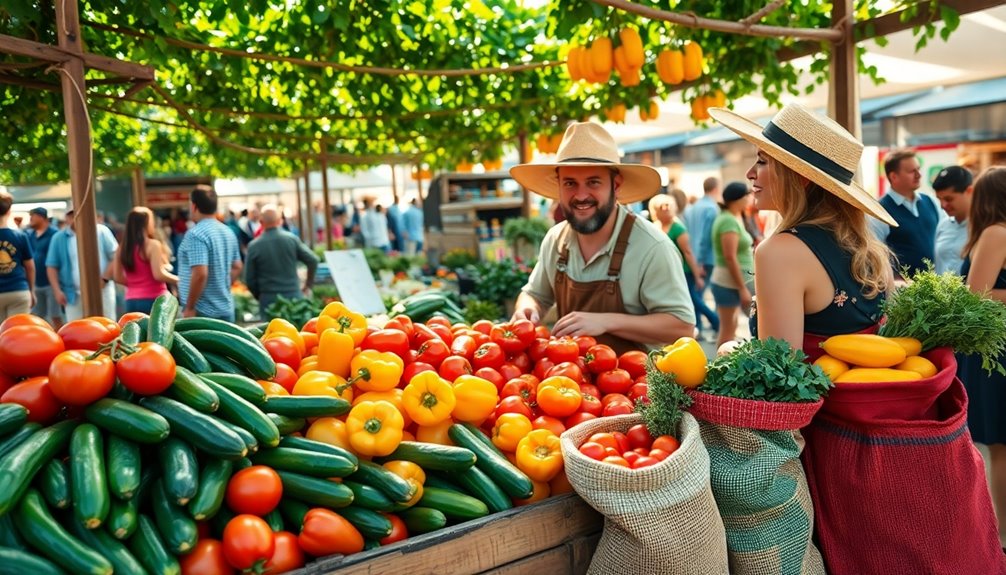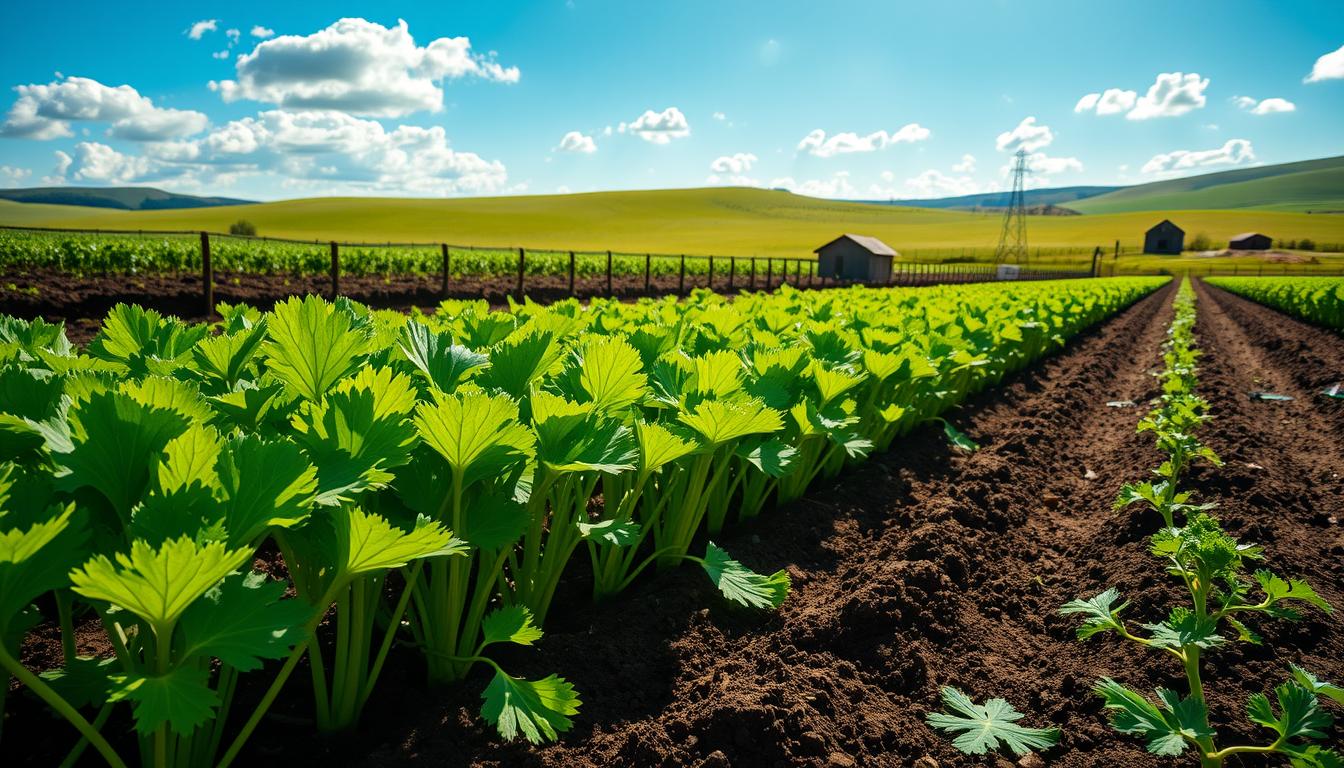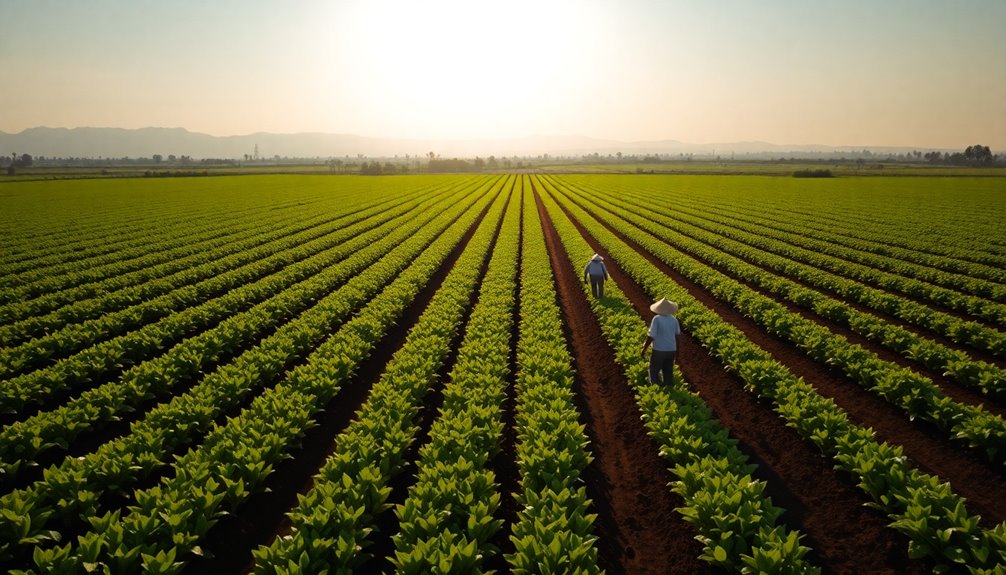To boost your farm's profits from selling vegetables, start by understanding local market demand. Conduct surveys to gauge community preferences and seasonal trends. Use direct-to-consumer strategies like CSAs and online sales to increase your profit margins. Build partnerships with local restaurants and grocery stores for steady orders. Implement effective marketing, like distributing pamphlets and newsletters to attract customers. Set competitive prices by researching your rivals and offering bulk discounts. Finally, maintain high-quality standards to command premium prices. You'll uncover even more effective tactics to enhance your sales strategy by exploring further.
Key Takeaways
- Conduct surveys to align your offerings with community preferences and seasonal trends, enhancing customer satisfaction and sales potential.
- Explore direct-to-consumer strategies like CSA subscriptions and online sales, which can significantly boost profit margins.
- Build partnerships with local businesses and restaurants to secure consistent orders and enhance your market visibility.
- Implement tiered pricing strategies, offering discounts for bulk purchases to encourage larger sales and increase overall revenue.
- Maintain rigorous quality assurance processes and engage customers through newsletters, providing educational content to establish trust and loyalty.
Understanding Market Demand
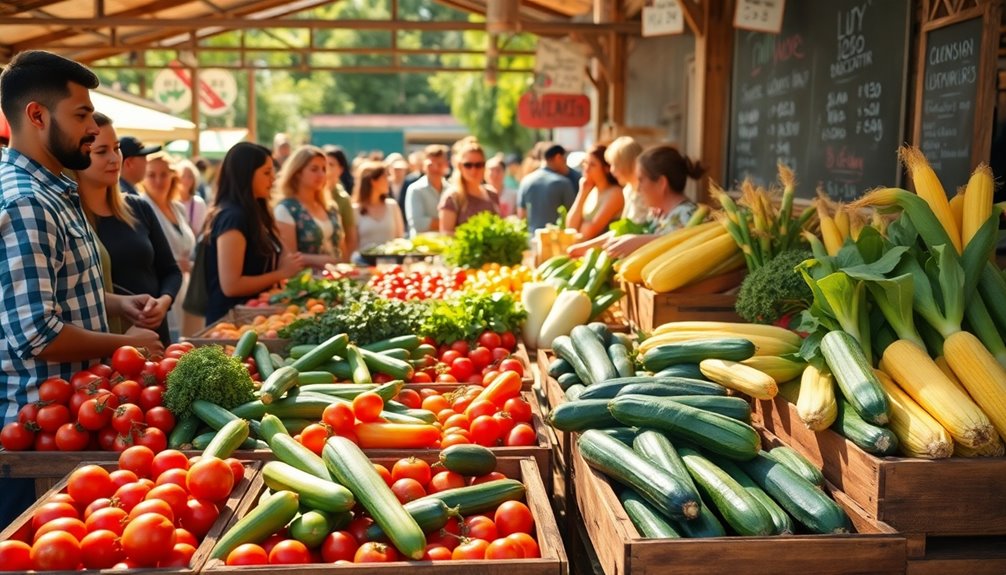
Understanding market demand is essential for successfully selling vegetables, especially since consumer preferences can shift rapidly. To align your vegetable offerings with community demand, conduct surveys that identify local preferences and seasonal trends. This approach helps enhance your sales potential.
Utilize local farmers markets as a crucial channel to engage directly with consumers, allowing you to gather immediate feedback and build relationships. Additionally, analyze your competitors to understand their pricing strategies and product availability, ensuring you position your vegetables effectively.
Exploring Sales Channels
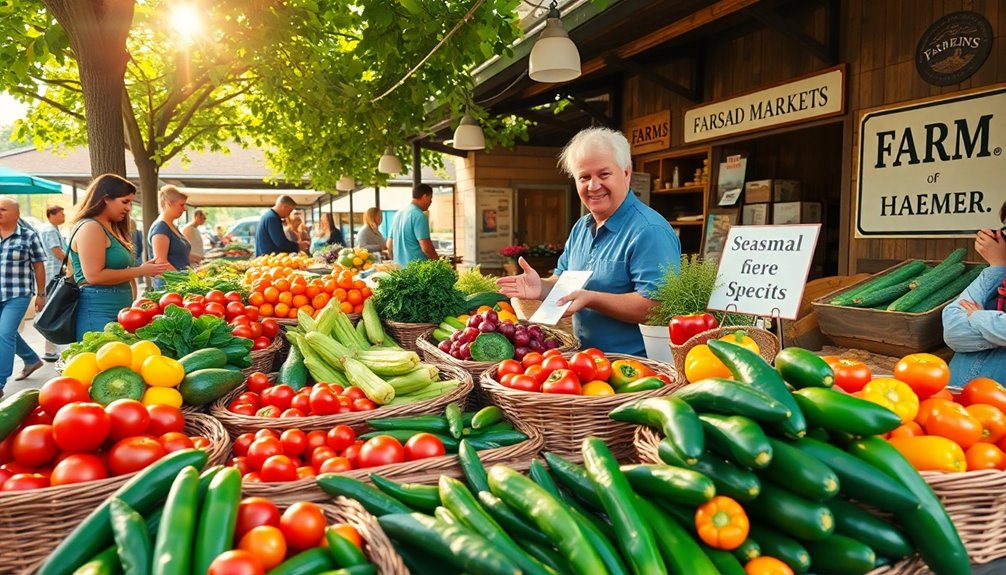
When you explore different sales channels, you'll find that direct-to-consumer options can really boost your profits.
Forming local partnerships with restaurants and grocery stores not only creates a steady demand but also elevates your farm's presence in the community.
Plus, tapping into online sales opportunities expands your reach and keeps you competitive in the market.
Direct-to-Consumer Sales
Direct-to-consumer sales channels like farmers markets and roadside stands give you the opportunity to connect directly with your customers while boosting your profits. By selling directly to consumers, you can eliminate middlemen and build meaningful relationships, making your local produce more appealing.
Consider these strategies to enhance your direct sales:
- Offer Community Supported Agriculture (CSA) subscriptions for consistent income.
- Utilize online platforms for home delivery or pick-up options.
- Engage local restaurants for seasonal supply agreements to guarantee steady demand.
- Participate in farmers markets to increase visibility and foster community loyalty.
As consumers increasingly seek fresh, locally sourced products, these channels can greatly elevate your farm's profitability while strengthening your ties to the community. Additionally, attracting pollinators through diverse planting can enhance your farm's ecosystem, making your produce even more appealing.
Local Partnerships Benefits
Building on the connections established through direct-to-consumer sales, forming local partnerships can greatly broaden your reach and enhance profitability.
By collaborating with local restaurants, you can guarantee a consistent demand for your seasonal produce, as chefs seek fresh ingredients to elevate their menus.
Partnering with independent grocery stores allows you to tap into a wider customer base, especially if they prioritize local sourcing.
Joint marketing efforts with other vendors at farmers markets can also amplify visibility and attract more customers.
Additionally, engaging in community events strengthens ties and fosters customer loyalty.
These relationships not only provide a reliable revenue stream but also create a mutually beneficial ecosystem where local produce thrives and local restaurants flourish.
Online Sales Opportunities
Exploring online sales opportunities can considerably transform how you connect with customers and sell your vegetables. By leveraging the internet, you can reach a broader audience and maximize your profits.
Here are some effective strategies to take into account:
- Create an engaging e-commerce website to showcase your fresh produce.
- Utilize subscription box services for regular deliveries, encouraging repeat business.
- Promote your offerings through social media, sharing recipes and special promotions.
- Collaborate with local delivery services to guarantee timely and fresh product distribution.
With these approaches, you can reduce dependency on local farmers' markets and build a consistent revenue stream. Additionally, leveraging social media platforms can significantly enhance your marketing efforts and reach potential customers more effectively.
Embrace online sales to expand your customer base and enhance your farm's profitability.
Building Strong Partnerships
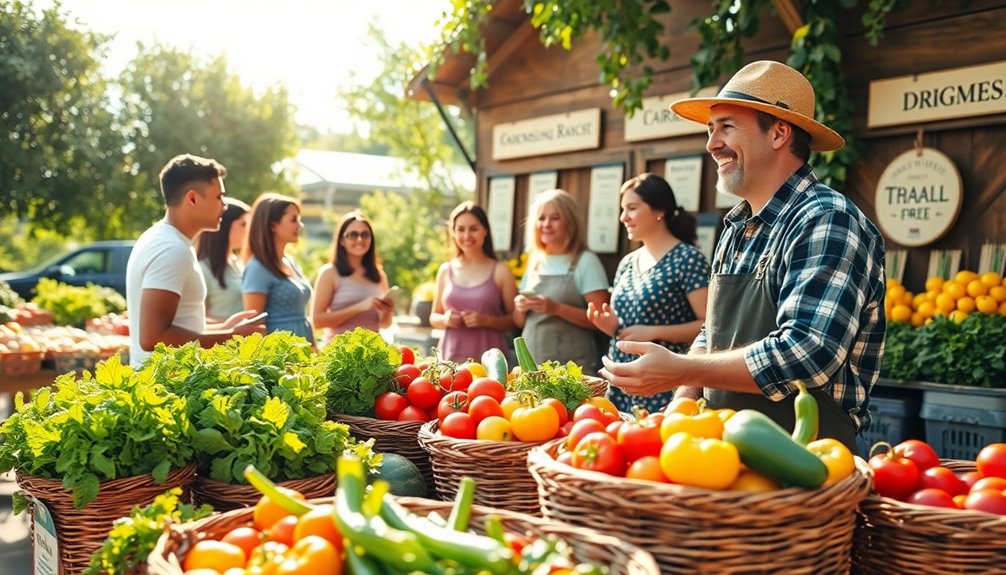
Building strong partnerships with local businesses, like restaurants and grocery stores, can greatly boost your vegetable sales.
By networking with chefs who value fresh, seasonal ingredients, you not only secure consistent orders but also strengthen community ties.
Collaborating with other vendors at farmers markets enhances your offerings and attracts more customers, creating a win-win situation for everyone involved. Additionally, fostering relationships with pet-friendly cafes can create opportunities for puppy socialization events, attracting more visitors and potential customers to your farm.
Local Business Collaborations
When it comes to selling vegetables, forging strong partnerships with local businesses can greatly boost your success.
Collaborating with local restaurants and markets not only enhances your visibility but also guarantees a steady demand for your seasonal produce.
Here are some effective strategies:
- Partner with independent markets to diversify your sales channels.
- Collaborate with local restaurants that value farm-to-table practices.
- Engage in joint marketing efforts at farmers markets to reduce costs.
- Build relationships with local grocery stores enthusiastic to support local food.
Networking With Chefs
To thrive in the competitive world of selling vegetables, networking with local chefs is essential. Start selling your produce by establishing strong relationships with them; 80% prefer sourcing from nearby farms for freshness.
Consider offering exclusive access to unique crops, which can set your farm apart and encourage chefs to feature your products on their menus. Hosting tasting events or farm tours showcases your offerings and fosters personal connections that lead to loyal partnerships.
Regular communication through newsletters highlighting available produce and seasonal recipes keeps your farm top-of-mind. Additionally, collaborating on special events like farm-to-table dinners enhances visibility and demonstrates your product quality, ultimately driving up demand and profits.
Working with chefs is a win-win for both parties. Furthermore, digital creativity in marketing can help amplify your outreach and create engaging content that attracts more culinary partners.
Legal Regulations and Certifications
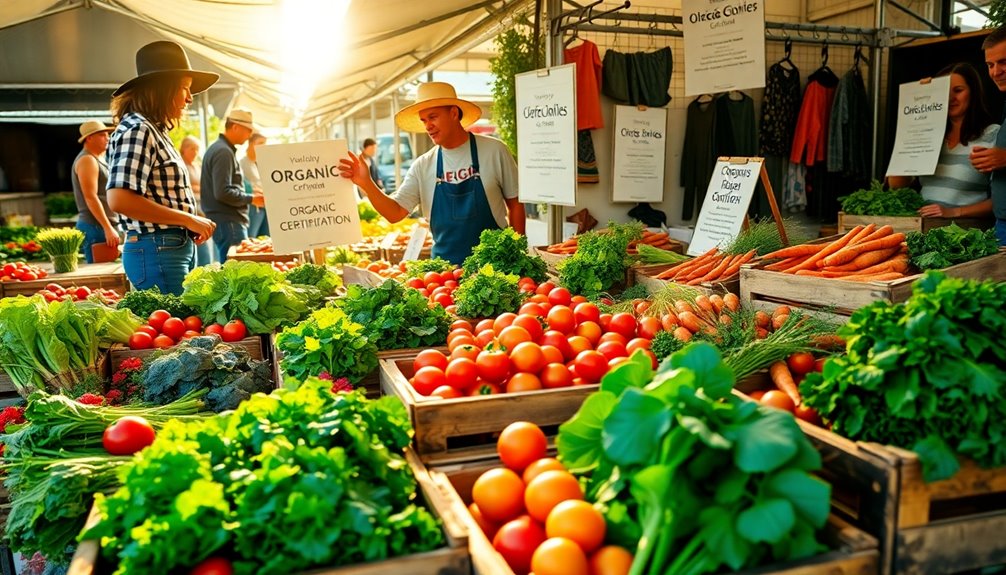
Maneuvering the legal landscape for selling vegetables requires understanding and complying with various regulations and certifications. Familiarize yourself with local legal regulations as they differ by state and municipality. Compliance with food safety standards is essential to avoid penalties and guarantee consumer safety.
Here are some key points to contemplate:
- Obtain necessary permits and licenses for direct sales.
- Adhere to cleanliness and proper labeling of your produce.
- Research zoning laws that may restrict where you can sell, like roadside stands.
- Think about pursuing organic certification or Certified Naturally Grown (CNG) for a simpler, lower-cost alternative.
Stay updated on any changes in labeling requirements to communicate your claims accurately and legally, especially for organic and non-GMO products.
Effective Marketing Techniques
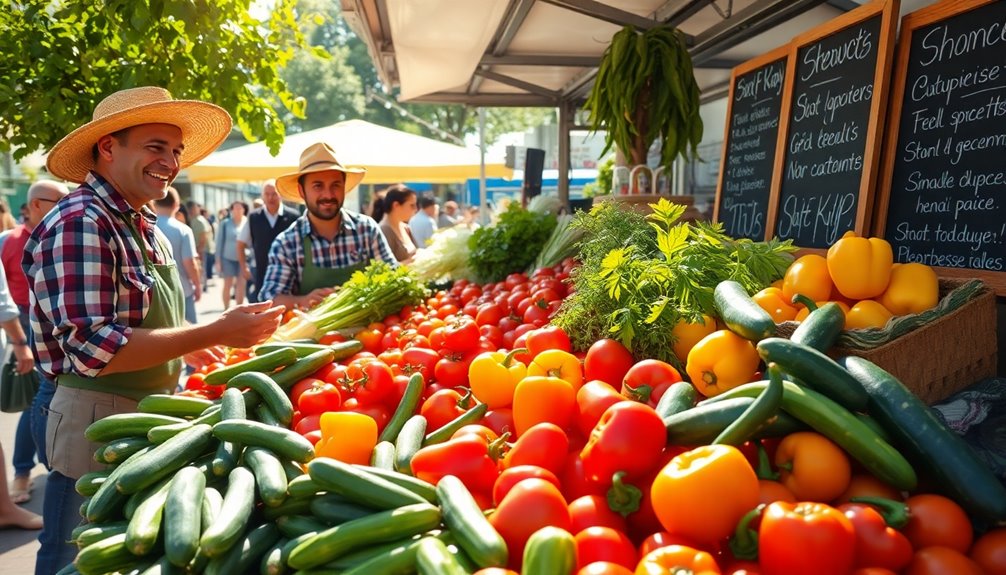
Effective marketing techniques can considerably boost your vegetable sales, especially in a competitive market.
Start by utilizing social media platforms like Instagram and Facebook to showcase your produce with stunning visuals. Since 54% of consumers prefer interacting with brands online, engaging updates and promotions can draw attention.
Don't forget to develop a farm pamphlet that highlights your unique selling points and seasonal offerings, distributing it at local markets and events to increase visibility.
Participating in local farmers' markets allows you to sell to local consumers directly, building loyalty through immediate feedback.
Implement an email newsletter to keep customers informed about specials, and collaborate with local chefs to feature your produce on their menus, enhancing your brand visibility in the community. Additionally, consider building a strong personal brand to attract a wider customer base and foster customer loyalty.
Pricing Strategies for Profitability
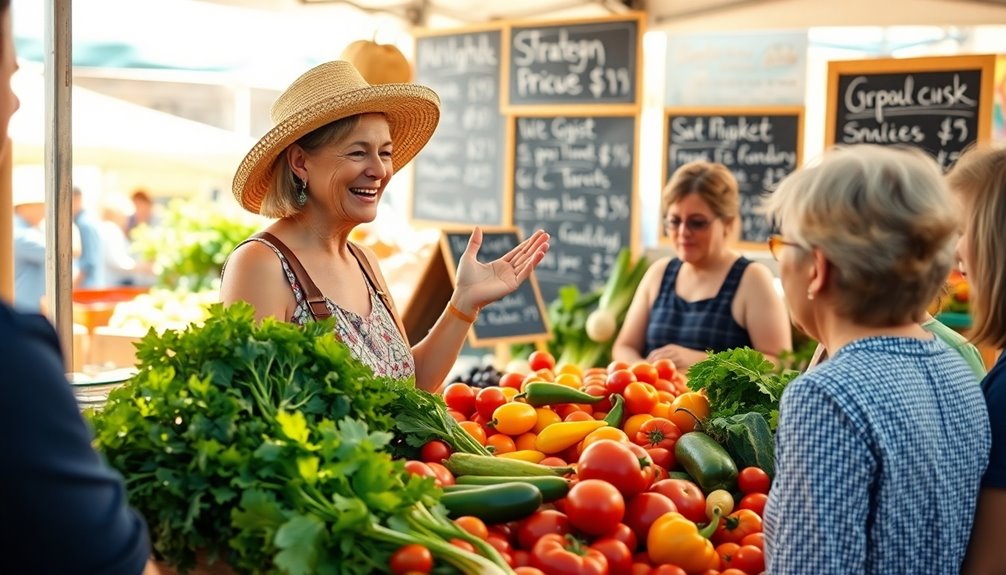
Setting the right prices for your vegetables is essential for maintaining profitability and staying competitive in the market.
To guarantee success, you need to contemplate several strategies:
- Calculate total production costs, including labor and distribution, to set prices that cover expenses.
- Research competitor pricing to establish a competitive edge while highlighting your product's uniqueness.
- Implement tiered pricing, such as discounts for bulk purchases, to encourage larger sales.
- Regularly review and adjust your pricing based on seasonal changes and customer feedback.
Quality Assurance and Readiness
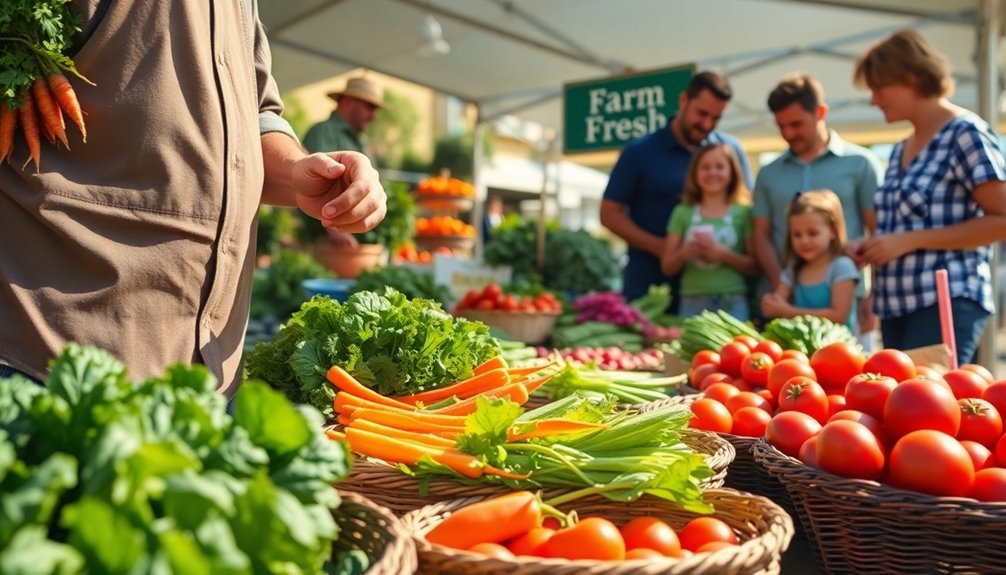
To maintain a competitive edge in the vegetable market, guaranteeing product quality is just as important as your pricing strategies. Implementing rigorous quality assurance processes, like grading and sorting, boosts consumer satisfaction and allows you to command premium prices.
Focus on effective postharvest handling techniques to maintain freshness and minimize spoilage, which directly influences your sales outcomes.
When you set up at farmers markets or roadside stands, organize your displays neatly and clearly mark prices to enhance product visibility.
Stock essential supplies, such as shopping bags and change for cash transactions, to guarantee smooth operations.
Developing Selling Skills
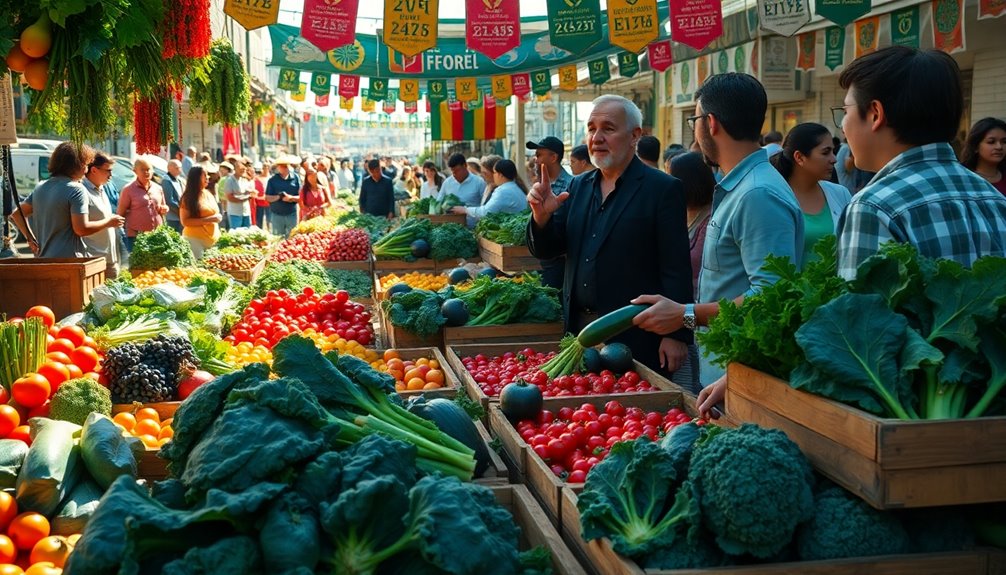
While selling vegetables might seem straightforward, developing strong selling skills can make a significant difference in your success at markets.
It's a good idea to focus on mastering the four-step selling process. This takes time, but the benefits are worth it.
- Build relationships with customers to foster trust.
- Discover customer needs through persuasive questioning.
- Advocate for your products by highlighting their benefits.
- Provide quality service to guarantee customer satisfaction.
Practicing these techniques and offering product samples can help guarantee increased interest and sales.
Fostering Customer Relationships
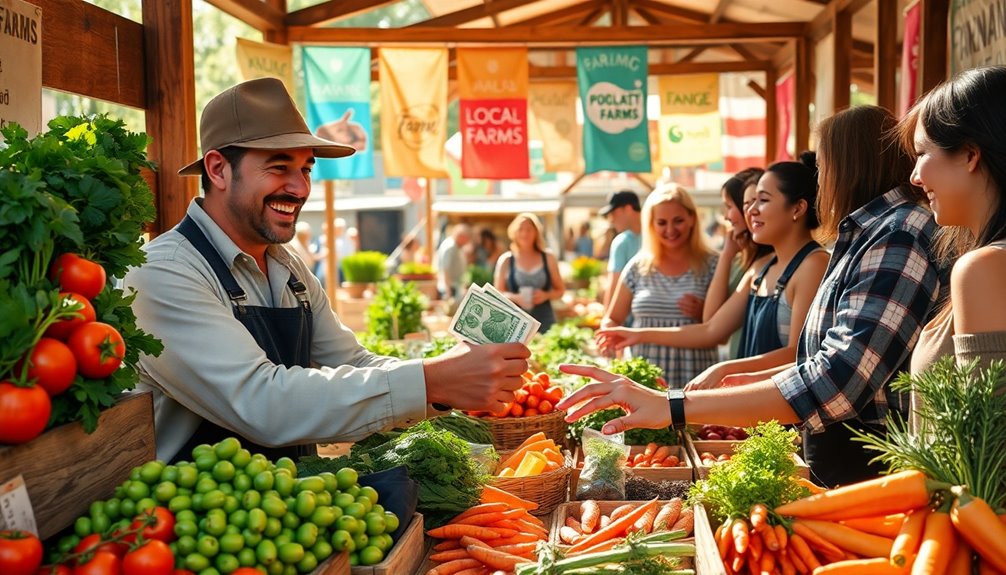
Building strong customer relationships is essential for any successful vegetable-selling venture. By keeping in touch through newsletters or social media, you can inform customers about your locally grown products and upcoming promotions. Offering educational content like recipes or growing tips adds value and positions your farm as a trusted source. Consider implementing a loyalty program or giving away discounts for repeat purchases, which encourages customers to come back. Personalize interactions by remembering names and preferences to enhance their shopping experience. Implementing these strategies can create a lasting emotional connection that encourages customer loyalty. Here's a quick overview of strategies:
| Strategy | Benefit |
|---|---|
| Regular Communication | Keeps customers engaged |
| Educational Content | Establishes trust |
| Loyalty Programs | Incentivizes repeat business |
| Personalized Service | Strengthens emotional connections |
Frequently Asked Questions
What Is the Most Profitable Vegetable to Sell?
When you're looking for the most profitable vegetable to sell, consider leafy greens like spinach and kale.
They're in high demand and can yield $3 to $5 per pound, making them a lucrative choice.
Plus, they've quick growth cycles, allowing for rapid turnover.
What Is the Most Profitable Thing to Sell on a Farm?
When considering what's most profitable to sell on your farm, think about high-demand crops and value-added products.
Fresh vegetables like heirloom tomatoes or peppers can bring in impressive profits.
Additionally, creating products like pickles or sauces from surplus can greatly boost your income.
Don't overlook organic options either; they often command higher prices.
Direct sales at farmers' markets or through Community Supported Agriculture (CSA) models can also enhance your farm's profitability.
How to Make Money Selling Vegetables?
To make money selling vegetables, you need to diversify your sales channels. Consider farmers markets, CSA programs, and local restaurants.
Implement a pricing strategy that aligns with your production costs and market demand, ensuring competitiveness. You can also introduce value-added products like jams or pickles from surplus veggies.
Building relationships with local chefs can secure consistent demand, while participating in local events boosts your visibility and customer engagement, ultimately increasing your profits.
What Can a Farmer Do to Make His Farm More Profitable?
Imagine your farm as a vibrant tapestry, woven with diverse threads of opportunity. To make your farm more profitable, consider diversifying your sales channels.
Explore farmers markets or partner with local restaurants. Introduce value-added products like jams to enhance your margins. Building relationships with chefs guarantees a steady demand for your produce.
Also, analyze production costs regularly and adjust pricing based on market trends to keep your operations sustainable and thriving.
Conclusion
In the world of farming, remember that "you reap what you sow." By understanding market demand, exploring diverse sales channels, and fostering strong customer relationships, you're setting your farm up for success. Implement effective marketing techniques and pricing strategies, while ensuring quality assurance. As you build partnerships and navigate legal regulations, you'll not only boost your profits but also cultivate a loyal customer base. Embrace these strategies, and watch your farm flourish!

